Amshey Nurenberg
Amshey Markovich Nurenberg (Russian: Амшей Маркович Нюренберг; April 17, 1887 – 10 January 1979) was a Ukrainian, Russian and Soviet painter, graphic artist, art critic, and memoirist.
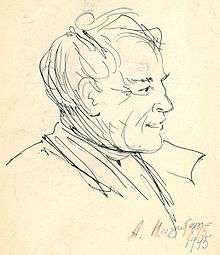
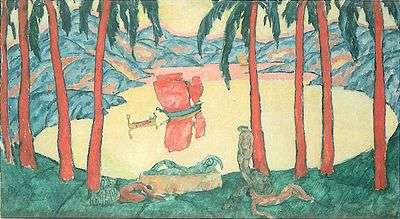
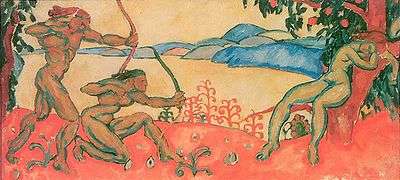
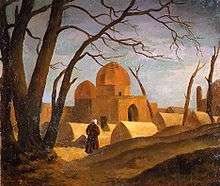
.jpg)
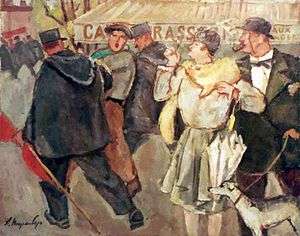
Born in Elisavetgrad, in 1904–1910 Nurenberg studied in the Odessa School of Arts with Professor Cyriaque Costandi. After having graduated from the School he continued his education in Paris. He lived in the Latin Quarter with other artists from Russia and during a year shared an atelier with M.Chagall in the phalanstery La Ruche.
In 1913 he returned to Odessa, where headed the group of modernists "The Independent", founded the private school "Free Studio" (1918), and participated in exhibitions of Odessa artists. After the Russian Revolution (1917) he was appointed to the People's Commissar of Arts of Odessa and to the head of the Committee for Protecting the Artistic and Historic Heritage.
Since 1920 he lived in Moscow, where was the first art columnist of the newspaper Pravda, worked in the ROSTA Windows together with Vladimir Mayakovsky, and was professor of history of the Western art at the VKhUTEMAS. In 1927–29 he was missioned to Paris by the People's Commissar for Education A. Lunacharsky to read lectures on new Soviet arts. In 1932 he has contributed to the organization of the Moscow Regional Union of Soviet Artists (МОССХ) which later has been extended to the USSR Union of Artists.
During World War II Nurenberg was in the evacuation in Tashkent (Uzbekistan). He continued to work as a painter and finished a series of anti-war paintings. After the war he has continued to work as an artist in Moscow, in particular for the Museum of Revolution.
During his life, Nurenberg has worked in different styles—from avant-garde to realism, having always remained faithful to traditions of the School of Paris.
Family
Wife: ballerina and artist Polina Mamichava Полина Николаевна Мамичева (1894–1978). Daughter: opera singer Nina Nelina (born Nurenberg) coloratura soprano, soloist of the Bolshoi Theater from 1946 to 1957 (Нина Нелина, 1923–1966) and wife of the writer Yury Trifonov; their daughter (granddaughter of A. Nurenberg): Dr. Olga Tangian Ольга Юрьевна Тангян (born Trifonova in 1951). One of brothers: the artist David Devinov Давид Девинов (Давид Маркович Нюренберг, 1896–1964).
Biography
April 21, 1887, birth in Elisavetgrad (now Kropyvnytskyi), Ukraine, in a Jewish family. Parents were fishmongers. Amshey was the eldest of 10 children.
1905 graduate from the Elisavetgrad high school, where the arts were taught by Ilya Repin's apprentice Feodosiy Kozachinsky
1905–11 studies at the Odessa School of Arts in the class of Professor Cyriaque Costandi
1911–13 stay in Paris, studies in private Academies of Arts, work as an art reporter for a newspaper in Russian "Paris Bulletin" (Парижский вестник). Share of an atelier with M.Chagall in the phalanstery La Ruche in the Passage de Dantzig
1913 return to Elisavetgrad, teaching activities
1915 move to Odessa, joint exhibitions with a group of modernists called later «Odessa Parisians». Organisation of the "Society of the Independent" transformed in 1918 into the "Association of Independent Artists"
1915 marriage with a ballerina Polina Mamichava (1894–1978)
1918 foundation of the "Free Studio" together with the "Children Academy". Teachers were the artists who studied in France (Amshey Nurenberg, Sigismund Olesevich, Alex (Sandro) Fasini, Theophil Freiermann, Isaak Malik). Among Nurenberg learners were Victor Midler (later the senior curator of the Department of the modern Russian art of the Tretjykov Gallery), wife Polina Mamicheva, and Naum Sobol (stage designer)
1919 People's Commissar of Arts of Odessa and the head of the Committee for Protecting the Artistic and Historic Heritage
1919–20 editor-in-chief of the first Soviet newspaper in Elisavetgrad "Red village" (Красная деревня)
1920 move to Moscow, work in the ROSTA Windows together with Vladimir Mayakovsky, Ivan Maljutin, and Mikhail Cheremnych; making over 200 posters
1921 organisation of the New Society of Painting (НОЖ) together with artists Alexander Gluskin, Samuel Adlivankin, Georgy Ryazhskiy, Mikhail Perutskiy, and others; writing the manifesto of the society
1921–22 mission to Uzbekistan together with Victor Midler and Polina Mamicheva for organisation of restoration of cultural and historic monuments
1922–24 professor of history of the Western art at the VKhUTEMAS
1923 birth of the daughter Nina (soloist of the Bolshoi Theater under the stage name Nina Nelina)
1923–25 joint exhibitions with the former members of the group Jack of Diamonds (1910–17) and writing the art manifesto for their new society Moscow Painters under the chairmanship of Pyotr Konchalovsky
1924–26 first arts columnist of the newspaper Pravda
1927–29 Mission to Paris by the People's Commissar of Education Anatoly Lunacharsky as "cultural ambassador" for lecturing on new Soviet arts and writing surveys on French arts for the Soviet press. Participation in the Paris Salon d'automne 1928
1930s contribution to the organisation of the Moscow Regional Union of Soviet Artists (МОССХ), work for the Museum of Revolution, trips to gather material for creative work to kolkhoz's of Ukraine and North-Caucasus and to coal-fields of Kuzbas
1941–43 evacuation to Tashkent during World War II. Work at the Uzbek Union of Soviet Artists
1943 return to Moscow. Work for the Museum of Revolution
1950s retirement. Continuation of active artistic and literary work, including participation in exhibitions, writing memoirs, and publications in newspapers and journals
January 10, 1979, death at the age of 91 in Moscow. Burial at the Vagankov cemetery.[1]
Works in museums
- Moscow, State Tretyakov Gallery: 67 works, including paintings Bourgeois Swines (1929–30), Supper (1930), Socialist contract (1931)
- Moscow, State Pushkin Museum of Fine Arts: 45 works
- Moscow, Mayakovsky Museum: 14 works, portraits of Mayakovsky of different years
- Moscow, State Museum of the East Nations Art: 69 works, Asia works of 1920s and 1940s
- Moscow, State Central Museum of Modern History of Russia (former Museum of Revolution): portraits of Lenin, revolution and antimilitary works
- Moscow, Central Armed Forces Museum (former Museum of Red Army): painting Happy Youth (1936)
- Kiev, National Art Museum of Ukraine: 39 works
- Kirovograd (Ukraine), Regional Art Museum: 102 works
- Nukus (Uzbekistan), State Art Museum of the Republic of Karakalpakstan named after I. V. Savitsky: about 60 works
- Ramat Gan (Israel), about 20 works
- Minneapolis (USA), The Museum of Russian Art (TMORA): 15 works
Exhibitions
- 1908, Odessa. Exhibition of the Association of South-Russian Artists (ТЮРХ)
- 1913, Jelisavetgrad. First Jelisavetgrad Art Exhibition
- 1916, Odessa. Exhibition of the Society of the Independent
- 1918, Odessa. Exhibition of the Association of Independent Artists
- 1919, Odessa. First People's Exhibition
- 1920, Odessa. Exhibition in Memory of T.Shevchenko
- 1922, Moscow. Exhibition of the New Society of Painting (НОЖ)
- 1924, Moscow. Joint exhibition of drawings and water-colours with Robert Falk and Alexander Shevchenko in the State Tsvetkov Art Gallery
- 1927, Paris. Salon d'automne
- 1929, Moscow. Exhibition «ROSTA Satiric Windows» in the State Tretyakov Gallery
- 1932, Venice. Bienale (Excerpt from the catalogue about USSR artists
- 1939, Moscow. Industry of Socialism
- 1945, Moscow. Personal exhibition in the Central House of Writers (ZDL)
- 1961, Moscow. Personal exhibition in the Moscow Department of the Union of Artiststs of the RSFSR (МОСХ РСФСР)
- 1963, Odessa. Personal exhibition
- 1979, Moscow. Posthumous personal exhibition at the Moscow Department of the Organisation of the Union of Artists of the RSFSR (МОСХ)
- 1988, Moscow. Exhibition of the Nukus Art Museum in the State Museum of the East Nations Art
- 2004, Moscow. Exhibition of Brothers Amshey Nurenberg and David Devinov-Nurenberg in the gallery «Kovcheg»
- 2006, Ramat Gan (Israel). Exhibition «Odessa Parisians» in the Zetlin Museum of Russian Art
- 2009, Kirovograd (Ukraine). Personal exhibition in the Regional Art Museum
- 2009, Odessa (Ukraine). City «exhibition» Art Museum
- 2010, Kiev. Exhibition of works of the Association of Independent Artists from the collection of Jacob Peremen in the Museum of Arts named after Bogdan and Varvara Khanenko
Membership in artistic unions
- 1910, Odessa. Association of South-Russian Artists (ТЮРХ)
- 1915–18, Odessa. Society of the Independent
- 1918–19, Odessa. Association of Independent Artists
- 1921–22, Моscow. New Society of Painting (НОЖ)
- 1926–27, Моscow. Association of artists of the revolutionary Russia (АХРР)
- 1932–79, Моscow. Moscow Regional Union of Soviet Artists (МОССХ), later renamed into Moscow Union of Soviet Artists (МССХ), Moscow Department of the Union of Artiststs of the RSFSR (МОСХ РСФСР), and Moscow Department of the Organisation of the Union of Artists of the RSFSR (МОСХ)
Books (Russian)
- V. Midler and A. Nurenberg (1922) Samarkand and Tashkent. Moscow - Tashkent, Risolya (Russian)
- A. Nurenberg (1924) Paul Cézanne. Moscow, VKhUTEMAS
- A. Nurenberg (1969). Reminiscences, acquaintances, thoughts about arts. Moscow, Soviet Artist (Russian: А. М. Нюренберг. Воспоминания, встречи, мысли об искусстве. Москва, Советский художник. 1969)
- A. Nuerenberg (2010) Odessa — Paris — Moscow. Memoirs of an artist. Editing and introductory article by O. Tangian. Concluding article by L. Voiskoun. Moscow, Gesharim (Russian)
Notes
Sources
- A. Nurenberg (1969). Reminiscences, acquaintances, thoughts about arts. Moscow, Soviet Artist (Russian: А. М. Нюренберг. Воспоминания, встречи, мысли об искусстве. Москва, Советский художник. 1969)
- A. Nurenberg (1994). Stories of an old artist. Time and ourselves (New York - Moscow), No. 124, 225–261, and No. 126, 216–259 (Russian: А. М. Нюренберг (1994). Рассказы старого художника. Время м мы (Нью-Йорк - Москва), №124, 225 - 261 и № 126, стр. 215 - 261)
- Odessa Parisians. Works of artists-modernists from the collection of Jacob Peremen (2006). Museum of Russian Art, Ramat-Gan, and publisher "Cultural bridges", Moscow (Одесские парижане. Произведения художников-модернистов из коллекции Якова Перемена (2006). Музей русского искусства, Рамат-Ган, и издательство "Мосты культуры", Москва. 2006)
- A.Nurenberg (2007). Odessa - Paris - Moscow. Reminiscences of an artist. Deribasovskaya - Rishelyevskaya. Odessa Anthology, Book 30, 208-225. (А. М. Нюренберг (2007). Одесса - Париж - Москва. Воспоминания художника. Дерибасовская - Ришельевская. Одесский альманах. Книга 30, стр. 208 - 225
- A. Nuerenberg (2010) Odessa — Paris — Moscow. Memoires of an artist. Editing and introductory article by O. Tangian. Concluding article by L. Voiskoun. Moscow, Mosty cultury - Gesharim (Russian)
- Amshey Nurenberg, about him (2008). Maslovka - Residence of Artists
- O. Tangian (2009). "Odessa Parisan" A.Nurenberg. Deribasovskaya - Rishelyevskaya. Odessa Anthology, Book 37, 182–206 (О. Тангян (2009). "Одесский парижанин" А.Нюренберг. Дерибасовская - Ришельевская. Одесский альманах. Книга 37, стр. 182 - 206)